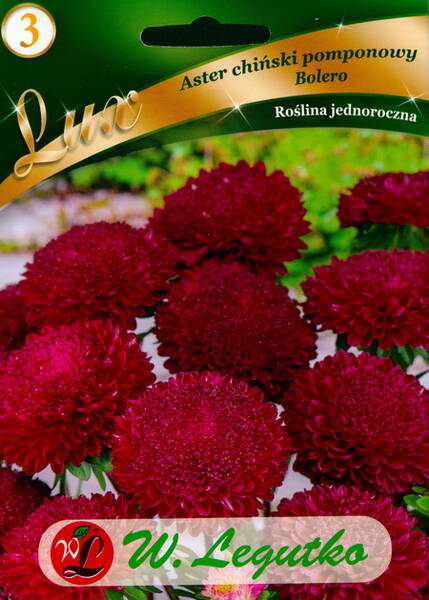Unusually spectacular colouring is what distinguishes the aster "Bolero" from its sisters.
To fully experience the power of her charms, choose this beautiful variety and it will take its rightful place in your beautiful garden!
Flowers on long and very strong stems that are just perfect for cutting. Plant up to 65 cm high, compact, strongly branched.
Inflorescences hemispherical, terry. Inflorescence diameter 12 cm.
The centre is filled with long tubular flowers, collected very tightly and coloured in the same way as reeds. Blooms in August-September.
It is used very widely: for planting in prefabricated flower beds in groups, for rows of flower beds and for cutting.
1.0 g = 450 seeds.
Agrotechnics.
The plant prefers an open sunny place but tolerates partial shade. Grows best in light, fertile soils. Does not tolerate the introduction of organic fertilizers in the year of planting.
Seeds are sown from mid-February to April. The seeding depth is 0.5 cm. At a temperature of +15°C, seedlings appear on the 7-14th day. After 3-4 weeks, the crops dive and grow at a temperature of +12+15°C. Seedlings are planted in the ground in the second half of May, the distance between plants is 20-30 cm.
* Aster is a rather unpretentious plant. It is not demanding on soils and tolerates drought and frost. But he loves the light. In the shade, the plants are strongly stretched and bloom poorly.
The main danger that awaits when growing asters is a fungal disease, popularly known as the "aster plague". The culprit of all the troubles is a mushroom from the genus Fusarium. Therefore, the disease itself is called Fusarium. Usually, it affects an already adult plant, which suddenly begins to fade. A brown crack appears on the stem and the leaves turn yellow and wither. The plant dies very quickly - sometimes in a couple of weeks.
Radical measures to combat fusarium have not yet been invented. The only salvation that somehow helps to contain the onslaught of the disease is a constant crop rotation. Every year, asters need to be planted in different places, and for seedlings, in no case should you take land from a flower bed where asters have already grown. The source of infection can be fresh manure, which cannot be brought into the ground even during autumn digging. Do not plant asters too densely. It is necessary that the plants are well-ventilated, especially in the zone of the root neck. And, of course, you need to choose varieties that are relatively resistant to Fusarium. Plants affected by the disease should be removed immediately, completely burning all plant debris.












